If you are starting a new website and are looking to create a content strategy, looking at what your competitors are currently ranking for will help you save a lot of time while also finding keywords that you may have missed out on. In addition, if you already have a website, looking at content gaps against your competitors will help you target and rank for keywords which you may have overlooked.
In this step-by-step guide, we will go through how to use competitor analysis with Ahrefs to discover high-value keywords and gain a serious SEO advantage over your competitors.
This article is for marketers, content strategists, SEO specialists, and founders looking to:
- Discover proven keywords already bringing traffic to others
- Find content gaps they can dominate
- Turn insights into a prioritized content roadmap
Let’s dive in.
What Is Keyword Research and Competitor Analysis?
Keyword Research is the process of finding words users put into search engines while searching for particular information.
Competitor analysis is studying what keywords your competitors are already ranking for that you aren’t and then writing better quality content for those keywords to outrank your competitors. This also helps you save time by not having to do keyword research from scratch.
For the bigger picture, competitor analysis will help you steal traffic from your competitors while also getting new organic traffic by ranking for new keywords. Overall, this would mean you will get more users to your website which leads to more inquiry about your products or services that ultimately leads to more revenue for your business.
Why Competitor Keyword Research is So Powerful?
In my personal experience, competitor keyword research has helped me save a lot of time by looking at what is already working for my competitors and reverse engineering my content to be updated and better than what is already ranking on the SERPs (Search Engine Results Page).
Generally, your audience may be similar to your competitors. This means you are able to understand specific insights in the problems and challenges they face through the specific queries they search for in the Search Engines.
What I have seen while conducting competitors keyword analysis is that the content is quite often outdated and not accurate to the current time this means there is an opportunity for you to bridge the gap while also providing new and accurate information, this can also be used to acquire backlinks through the sky scraper technique.
Ultimately this will lead to your page ranking faster and higher on the Search Engines by targeting low-difficulty but high-intent keywords they haven’t fully capitalized on.
Tools You Can Use For Keyword Research and Competitor Analysis (And Why We Prefer Ahrefs?)
When it comes to choosing the right tools, there are a plethora of tools you can use for keyword research and competitor analysis. Some examples are Ahrefs, Semrush, SpyFu, Mangools, Ubersuggest, Moz Pro and this list goes on and on and on.
I believe it all goes to personal preference and also which tool you started using first and became an expert in.
For me, I use Ahrefs, it was the first tool I started using for Keywords Research and found it to be quite useful with a simple to use user interface, what I also like about Ahrefs is they are constantly improving and adding new features.
Pro tip: You can pair Ahrefs with ChatGPT to cluster and interpret data faster, more on that later.
Step-by-Step: How to Do Keyword Research & Competitor Analysis in Ahrefs
There are multiple ways of doing competitor analysis, in this step by step guide we are going to use the content gap tool in Ahrefs.
In this example, we are going to look at Ahrefs Blog.
Step 1: Identify Your Real SEO Competitors
On Ahrefs, click ‘Site Explorer‘ and type in your target domain.
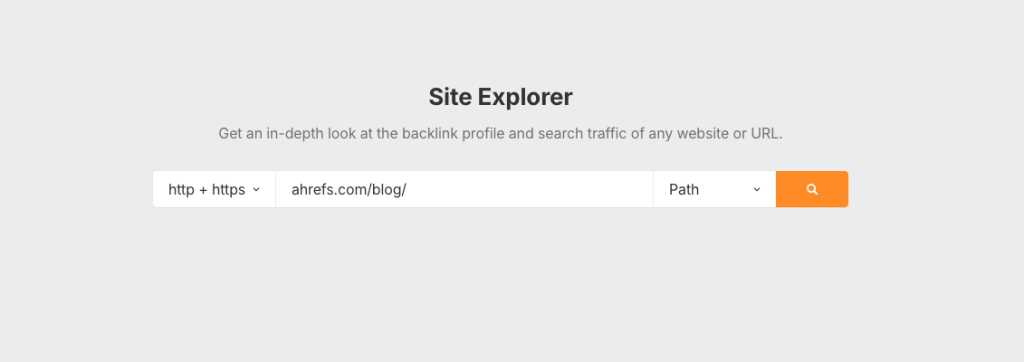
On the overview page, if you scroll down you will see a section where it says ‘Top Organic Competitors’, here you will see your competitors with whom you share the majority of your keywords.
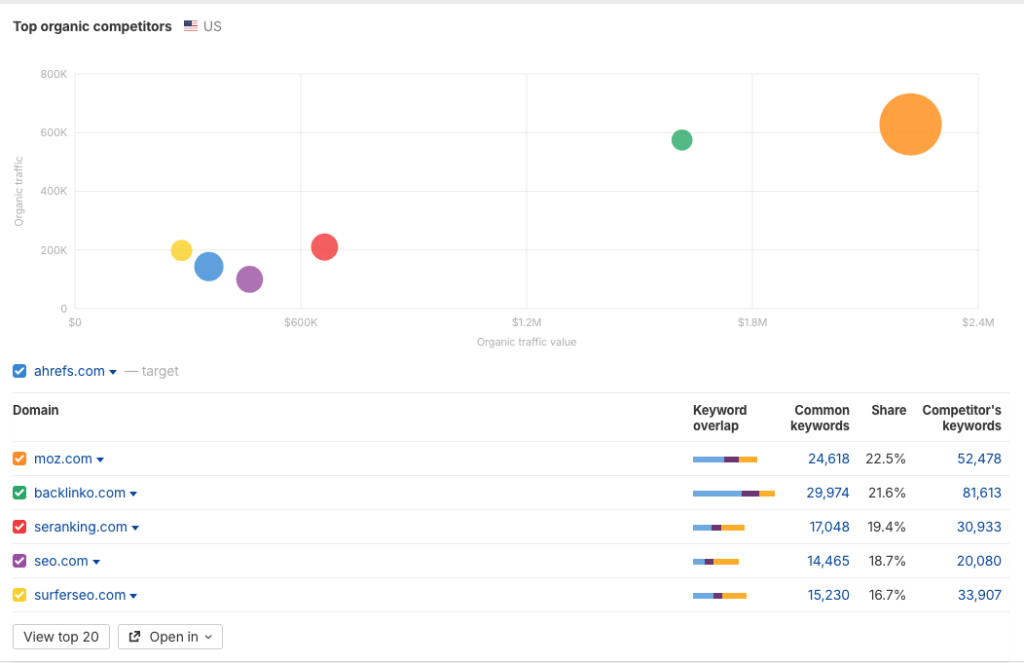
By clicking ‘View top 20‘, you will get a list of your competitors along with parameters such as competitor keywords, common keywords, target keywords, traffic, value.

But in this case we will click the ‘Open in‘ and select Content gap.
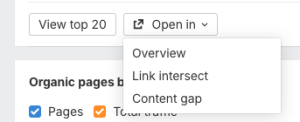
Here we see that our target page is being compared to our top 5 competitors.

Step 2: Analyze Competitor Keywords
Now there are two ways you can do this, the first one is very manual and time consuming as it requires you to go through each keyword that your competitor ranks for that you do not.
Instead, what we are going to do is use Ahrefs Content Gap Tool and first find keywords your competitors rank for, but your website isn’t ranking in the top 100 search results.
To do this, we are going to set the filters as follows:
In the filter section we are going to select:
- Target’s Position: No Rank

- Competitor’s Position: All rank [Top 5 competitors in top 100]
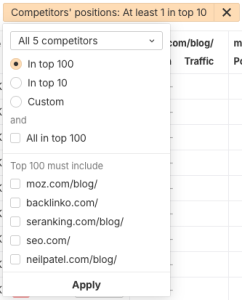
In this case, we get the following result:
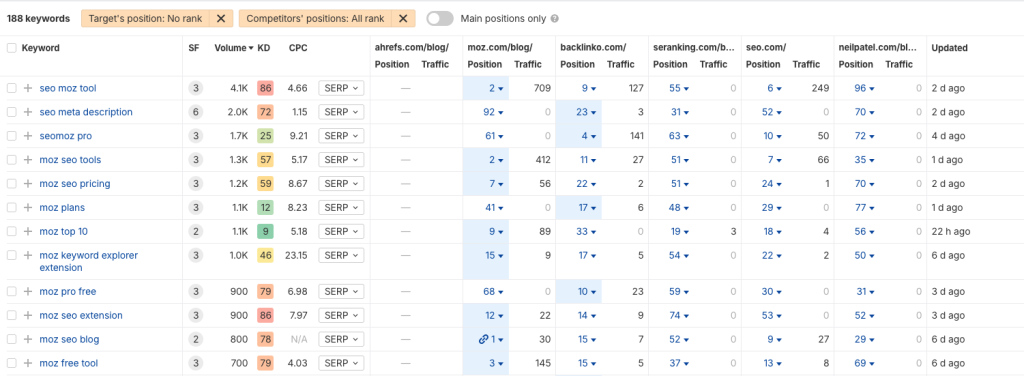
We have 188 keywords, that are competitors are ranking for in the top 100 positions that Ahrefs Blog is not.
One thing to remember here, is to always check the keyword results. Here, we see that certain keywords have ‘moz‘ in the user search intent. We can remove this by using the filter ‘Keyword‘.
Choose filter keyword and ‘Doesn’t contain’, keyword = ‘moz’.
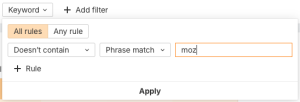
This eliminates keywords with moz in the output.
Now, the results will vary depending on the website you are searching for as well as the parameters entered in the filters. For example, filters like, Position < 20, Volume > 100, KD < 30.
Now, that we have a more clear list, we can select the keywords and copy them for the next step.
Step 3: Prioritize High-Value Keywords
You now have a big list, here’s how to make it useful:
- Intent: Is it informational, commercial, transactional?
- Business relevance: Does it align with your offering?
- Opportunity: Low difficulty, good volume, weak competition content?
Assign scores or ranks based on these criteria.
Step 4: Keyword Clustering
Instead of targeting single keywords, cluster related terms:
- Use Ahrefs’ Parent Topic column or export and group via Google Sheets
- Use AI tools like ChatGPT to auto-cluster based on semantic similarity
Pro Tip: You can use ChatGPT to help you with clustering the keywords into content pillars.
Use the following prompt in ChatGPT with your keywords.
‘You are a SEO expert, who have over 10+ years in catergorizing keywords into clusters based on user search intent, the main niche of the website is in (Website Niche) and here is the (Website Link), I will provide you with a list of keywords related to this niche, can you cluster them into relevant content pillars based upon which I can create articles for.‘
This will help speed up the process of clustering the keywords into relevant bucks.
Step 5: Content Strategy Based on Competitor Gaps
Now use your keyword clusters to:
- Build blog content plans
- Improve or rewrite service pages
- Develop topic clusters and internal linking strategies
What are some common mistakes to avoid?
- Copying keywords without understanding search intent
- Ignoring business relevance for short-term traffic spikes
- Targeting only high-volume, high-difficulty keywords
- Overlooking long-tail keywords with buyer intent
Conclusion
Competitor keyword analysis is one of the fastest ways to uncover what’s working—and reverse engineer success.
With Ahrefs and a step-by-step system, you’ll never run out of content ideas that are actually worth targeting.
Get a free SEO Audit for your website here.
FAQs (Frequently Asked Questions)
Q1: What’s the difference between keyword gap and overlap?
Overlap = keywords both you and competitor rank for. Gap = keywords only they rank for.
Q2: Can I do this for free without Ahrefs?
Free tools are limited. You can try Ubersuggest or manually using Google, but Ahrefs saves you 10x the time.
Q3: How often should I run competitor keyword research?
Ideally once per quarter, or every time you plan a new content sprint.


Leave a Reply